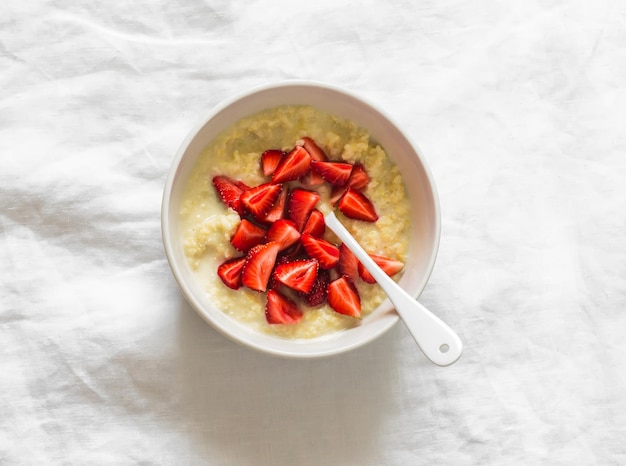7 Best High-Fiber Foods to Lower Cholesterol Naturally

The 7 best high-fiber foods to lower cholesterol by 15% in 3 months include oats, beans, nuts, apples, citrus fruits, flaxseeds, and barley, all contributing to improved heart health by reducing LDL cholesterol levels.
Are you looking to lower your cholesterol levels naturally? You’re likely wondering, what are the 7 best high-fiber foods to lower cholesterol by 15% in 3 months? Integrating high-fiber foods into your diet can significantly impact your heart health. Let’s dive into the specifics.
Understanding Cholesterol and the Role of Fiber
Cholesterol, a waxy substance found in your blood, is essential for building healthy cells, but high levels can increase your risk of heart disease. Fiber, on the other hand, is a type of carbohydrate that your body can’t digest. It helps regulate cholesterol levels by preventing the absorption of cholesterol into your bloodstream.
The Different Types of Cholesterol
- LDL Cholesterol (Low-Density Lipoprotein): Often referred to as “bad” cholesterol, high levels can lead to plaque buildup in your arteries.
- HDL Cholesterol (High-Density Lipoprotein): Known as “good” cholesterol, it helps remove LDL cholesterol from your arteries.
- Triglycerides: Another type of fat in your blood that, when elevated, can contribute to heart disease.
How Fiber Lowers Cholesterol
Fiber works its magic in a few key ways:
- Binding Cholesterol: Soluble fiber binds with cholesterol in the digestive tract, preventing its absorption.
- Promoting Bile Acid Excretion: Fiber increases the excretion of bile acids, which are made from cholesterol, thus reducing cholesterol levels.
- Supporting a Healthy Gut Microbiome: A fiber-rich diet promotes the growth of beneficial gut bacteria, which can further aid in cholesterol reduction.
In conclusion, understanding the role of cholesterol and how fiber interacts with it is crucial in making informed dietary choices for heart health. By incorporating the right types and amounts of fiber, you can proactively manage your cholesterol levels and reduce the risk of heart disease.
Oats: The Heart-Healthy Breakfast Choice
Oats are a fantastic source of soluble fiber, making them an excellent choice for breakfast. Their ability to lower LDL cholesterol levels has been well-documented.
Benefits of Oats for Cholesterol Reduction
- Beta-Glucan: Oats contain beta-glucan, a type of soluble fiber that’s highly effective in reducing LDL cholesterol.
- Easy to Incorporate: Oats can be easily added to your breakfast routine, whether as oatmeal, granola, or in smoothies.
- Satiety: The high fiber content in oats keeps you feeling full longer, which can help with weight management.

How to Prepare Oats for Maximum Benefit
To maximize the cholesterol-lowering benefits of oats:
- Choose Rolled or Steel-Cut Oats: These are less processed than instant oats and retain more fiber.
- Avoid Added Sugars: Opt for natural sweeteners like fruits or a small amount of honey.
- Combine with Other High-Fiber Foods: Add berries, nuts, or seeds to boost the fiber content and nutritional value of your oatmeal.
In summary, oats are a simple and effective way to kickstart your day with a heart-healthy breakfast. Regular consumption of oats can contribute significantly to lowering LDL cholesterol and improving overall cardiovascular health.
Beans and Legumes: A Fiber Powerhouse
Beans and legumes are nutritional powerhouses packed with fiber, protein, and essential nutrients. They are an excellent addition to any diet aimed at lowering cholesterol.
Types of Beans and Legumes to Include
There are various types of beans and legumes to choose from:
- Kidney Beans: Rich in soluble fiber, they are a great addition to salads, soups, and chili.
- Black Beans: Versatile and packed with fiber, they can be used in burritos, stews, and side dishes.
- Lentils: Easy to cook and highly nutritious, lentils are a great source of both soluble and insoluble fiber.
Health Benefits of Beans and Legumes
Incorporating beans and legumes into your diet can provide numerous health benefits:
- Improved Cholesterol Levels: The high fiber content helps lower LDL cholesterol and improve overall lipid profiles.
- Better Blood Sugar Control: Beans have a low glycemic index, which helps regulate blood sugar levels and prevent spikes.
- Weight Management: High in fiber and protein, beans promote satiety and can aid in weight management.
In conclusion, beans and legumes are a versatile and nutritious addition to any diet focused on lowering cholesterol. Incorporating them regularly can lead to significant improvements in heart health and overall well-being.
Nuts and Seeds: Healthy Fats and Fiber Combined
Nuts and seeds are nutritional powerhouses, offering a combination of healthy fats, fiber, and essential nutrients. Incorporating them into your diet can contribute to lowering cholesterol levels and promoting heart health.
Best Nuts and Seeds for Cholesterol Reduction
- Almonds: Rich in monounsaturated fats, fiber, and vitamin E, almonds can help lower LDL cholesterol.
- Walnuts: Packed with omega-3 fatty acids and fiber, walnuts support heart health and reduce cholesterol levels.
- Flaxseeds: An excellent source of soluble fiber and omega-3 fatty acids, flaxseeds can be easily added to smoothies, yogurt, or baked goods.
How Nuts and Seeds Improve Cholesterol Levels
Nuts and seeds improve cholesterol levels through several mechanisms:
- Healthy Fats: Monounsaturated and polyunsaturated fats help lower LDL cholesterol and raise HDL cholesterol.
- Fiber: Soluble fiber binds with cholesterol in the digestive tract, preventing its absorption.
- Plant Sterols: Some nuts and seeds contain plant sterols, which can further reduce cholesterol absorption.
Therefore, nuts and seeds are not only a tasty snack but also a valuable addition to a heart-healthy diet. Their combination of healthy fats, fiber, and essential nutrients makes them an effective tool for managing cholesterol levels and promoting overall cardiovascular health.

Fruits: Apples and Citrus for a Daily Dose of Fiber
Fruits, particularly apples and citrus varieties, offer a delicious and convenient way to increase your fiber intake and support heart health. These fruits are rich in soluble fiber, which can help lower cholesterol levels naturally.
The Benefits of Apples and Citrus Fruits
- Apples: Apples contain pectin, a type of soluble fiber that binds with cholesterol in the digestive tract, preventing its absorption into the bloodstream.
- Citrus Fruits: Oranges, grapefruits, lemons, and limes are rich in soluble fiber and vitamin C, both of which contribute to heart health.
- Antioxidants: Both apples and citrus fruits are packed with antioxidants, which help protect against oxidative stress and inflammation.
Incorporating Apples and Citrus into Your Diet
To maximize the benefits of apples and citrus fruits:
- Eat Whole Fruits: Eating the whole fruit provides more fiber than drinking juice.
- Add to Meals and Snacks: Include slices of apples or oranges in salads, oatmeal, or yogurt.
- Variety: Choose different varieties to ensure you are getting a range of nutrients and antioxidants.
In conclusion, apples and citrus fruits are versatile and nutritious choices for increasing your fiber intake and promoting heart health. Adding these fruits to your daily diet can help lower cholesterol levels and provide a range of other health benefits. They are a simple and tasty way to support your overall well-being.
Barley: An Ancient Grain for Modern Health
Barley is an ancient grain with a rich history and numerous health benefits. It’s an excellent source of soluble fiber, making it a valuable addition to diets aimed at lowering cholesterol and improving heart health.
The Nutritional Benefits of Barley
- Soluble Fiber: Barley is high in beta-glucan, the same beneficial fiber found in oats, which helps lower LDL cholesterol levels.
- Minerals and Vitamins: Barley is a good source of essential nutrients, including magnesium, selenium, and niacin.
- Low Glycemic Index: Barley has a low glycemic index, which means it doesn’t cause rapid spikes in blood sugar levels, making it suitable for people with diabetes.
How to Incorporate Barley into Your Diet
Barley can be added to your diet in numerous ways:
- Soups and Stews: Add barley to soups and stews for a hearty and nutritious meal.
- Salads: Use cooked barley as a base for salads, combining it with vegetables, herbs, and dressings.
- Side Dish: Serve barley as a side dish instead of rice or other grains.
Ultimately, barley is a versatile and nutritious grain that offers numerous health benefits. By incorporating it into your diet, you can help lower cholesterol levels, improve digestion, and enjoy a wide range of essential nutrients. It’s a simple and effective way to support your overall health and well-being.
Flaxseeds: Small Seeds with Big Benefits
Flaxseeds are small but mighty seeds packed with nutrients, including fiber, omega-3 fatty acids, and lignans. They are a valuable addition to any diet aimed at lowering cholesterol and improving heart health.
The Health Benefits of Flaxseeds
Incorporating flaxseeds into your diet offers several benefits:
- Improved Cholesterol Levels: The soluble fiber in flaxseeds helps lower LDL cholesterol and improve overall lipid profiles.
- Heart Health: Omega-3 fatty acids reduce inflammation and support cardiovascular health.
- Antioxidant Properties: Lignans act as antioxidants, protecting against oxidative stress and reducing the risk of chronic diseases.
How to Use Flaxseeds
Flaxseeds can be used in various ways to enhance your diet:
- Ground Flaxseeds: Use ground flaxseeds as opposed to whole flaxseeds because the ground form is easier to digest.
- Add to Smoothies: Mix ground flaxseeds into smoothies for a nutritious boost.
- Baking: Incorporate flaxseeds into baked goods like muffins, bread, and cookies.
In conclusion, flaxseeds are a versatile and nutrient-rich food that can significantly benefit your heart health. By incorporating them into your diet, you can lower cholesterol levels, reduce inflammation, and enjoy a wide range of essential nutrients. Small but mighty, flaxseeds are a fantastic addition to a heart-healthy lifestyle.
| Key Point | Brief Description |
|---|---|
| 🍏 Apples & Cholesterol | Pectin in apples binds cholesterol, reducing its absorption. |
| 🌾 Oats & LDL | Beta-glucan in oats lowers LDL cholesterol effectively. |
| 🥜 Nuts & Heart Health | Healthy fats in nuts raise HDL, lowering LDL. |
| 🌱 Flaxseeds & Omega-3s | Flaxseeds provide fiber and Omega-3s, aiding cholesterol reduction. |
Frequently Asked Questions (FAQ)
▼
Yes, diet can significantly lower cholesterol. Consuming high-fiber foods, healthy fats, and limiting saturated fats can help reduce LDL cholesterol levels naturally.
▼
Aim for at least 25-35 grams of fiber per day. Incorporating various high-fiber foods like oats, beans, and fruits can help you reach this goal and lower cholesterol.
▼
Eating too much fiber can cause gas, bloating, and abdominal discomfort. Gradually increase your fiber intake and drink plenty of water to minimize these side effects.
▼
Significant changes can be seen within 3 months. Consistent adherence to a cholesterol-lowering diet can lead to a 15% reduction in LDL cholesterol levels over this period.
▼
Supplements can help, but they shouldn’t replace whole, high-fiber foods. Foods offer a broader range of nutrients and benefits, making them a preferred choice.
Conclusion
Incorporating the 7 best high-fiber foods to lower cholesterol by 15% in 3 months, such as oats, beans, nuts, apples, citrus fruits, flaxseeds, and barley, can significantly improve your heart health. Make these foods a regular part of your diet to manage cholesterol levels naturally and effectively.
